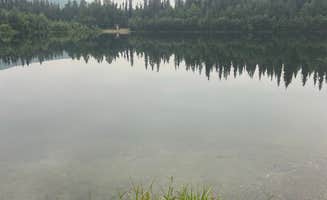Dispersed camping areas near Fairbanks, Alaska offer primitive outdoor experiences in the Interior region. Summer temperatures typically range from 50-80°F with extended daylight hours, while winter camping requires specialized cold weather gear for temperatures that can drop below -40°F. Road conditions to rustic camping sites vary seasonally, with some areas inaccessible during spring breakup when snow melt creates muddy, unstable surfaces.
What to do
Fishing opportunities: At Mile 48 on Chena Hot Springs Road, two small lakes provide productive fishing spots. "We stopped here on our way out of Chena hot springs and went fishing. We were the only ones there and it was so peaceful," notes Riley N. about Mile 48, Chena Hot Springs Road.
Wildlife observation: Colorado Creek offers beaver watching and fishing opportunities. A camper at Colorado Creek Trailhead Dispersed Camping reports, "The beavers are very active and we caught a few little trout here." Bring binoculars for viewing wildlife from a safe distance.
Stargazing: Despite summer's extended daylight, spring and fall camping provide darker skies ideal for aurora viewing. The Elliott Highway sites offer tree cover that creates darker conditions even during longer daylight periods. For optimal northern lights viewing, plan visits between August and April when darkness returns to the region.
What campers like
Privacy and seclusion: The tree cover at Elliott Highway locations creates secluded camping spots. "We were the only ones here and tucked away behind all of the trees and fireweed," shares a visitor to Elliott Highway Pulloff Loop- Dispersed Camping, noting that "road noise was mild and it got fairly dark under the cover of the trees."
Weekday solitude: Campers report that many dispersed camping areas near Fairbanks experience lower usage during weekdays. "Busy on the weekends but empty during the week," observes Bradee A. about Mile 48 pond, making midweek visits optimal for those seeking quiet experiences.
Convenience for appointments: Roadside camping spots provide practical overnight options when visiting Fairbanks for services or appointments. James B. describes roadside camping spot as "Good spot to kill some time and relax outside Fairbanks" and notes it was "pretty quiet for sleeping" despite highway proximity.
What you should know
Insect protection: Multiple reviewers emphasize the importance of effective mosquito deterrents. "We didn't even get out of our van because the mosquitoes were so bad," reports one camper at Elliott Highway Pulloff Loop. Another advises about Colorado Creek: "Make sure you've got bug spray cause they're BAD up here." Bring head nets, insect repellent with DEET, and consider a screen shelter for eating areas.
Wildlife encounters: Porcupines, beavers, and other wildlife frequent these camping areas. One visitor to Elliott Highway mentions: "We also saw two porcupines here as well." Food storage in wildlife-proof containers is essential to prevent attracting bears and smaller mammals.
Solar capabilities: Roadside areas outside Fairbanks often provide adequate clearings for solar power generation. James B. notes about 48 Mile Pond Camp: "Good open area so solar and Starlink were happy." Campers relying on solar should consider summer's extended daylight as an advantage for power generation.
Tips for camping with families
Site selection for children: Choose camping spots with adequate clearings for play areas but maintain distance from water features for safety. Sites with established fire rings provide safer cooking and gathering areas for families.
Educational opportunities: Colorado Creek and other beaver-active areas offer wildlife viewing opportunities. Pack field guides specific to interior Alaska wildlife and plants to engage children in identification activities.
Timing considerations: When camping with children, schedule visits during lower mosquito seasons (late August to early September) for more comfortable outdoor experiences. Early summer camping requires more extensive insect protection measures for young children.
Tips from RVers
Leveling sites: Roadside locations often provide relatively level surfaces for larger vehicles. One RVer notes, "Easy to get level" at roadside camping areas near Fairbanks. Carry leveling blocks for minor adjustments at less developed sites.
Access road assessment: Road conditions to dispersed camping areas vary substantially by season. Travel during daylight hours to assess creek crossings and soft road sections before committing to sites with larger vehicles.
Communication access: Cellular reception varies significantly between camping areas. Satellite communication devices serve as important backups in areas with limited connectivity, particularly for extended stays or winter camping experiences.


